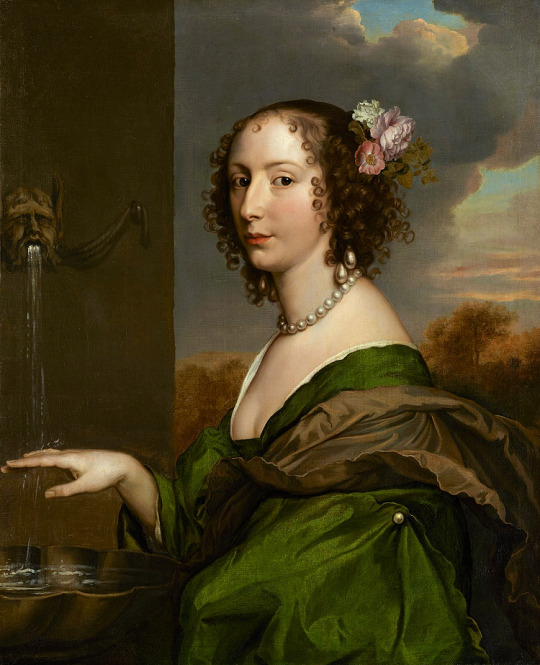#Adriaen Hanneman
Text

1655 Adriaen Hanneman - Portrait of a Man
(Dulwich Picture Gallery)
215 notes
·
View notes
Photo

Adriaen Hanneman (Dutch, 1603-1671)
Portrait of Maria Henriette Stuart, Prince Willem II of Oranje with a Negro Page, c.1664
Mauritshuis Royal Picture Gallery
#art#fine art#traditional art#Adriaen Hanneman#dutch#dutch art#1600s#classical art#Maria Henriette Stuart#oil painting#women in art#fine arts#european art#western civilization#europe#europa#female portrait#female#portrait#orientalism
37 notes
·
View notes
Photo
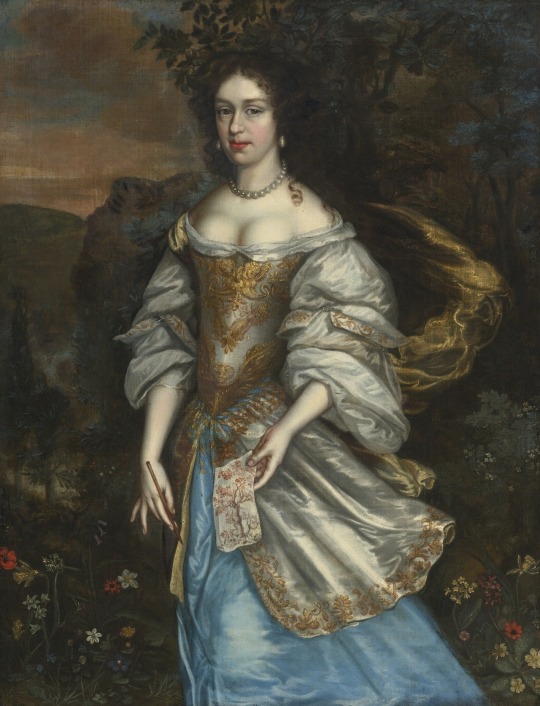


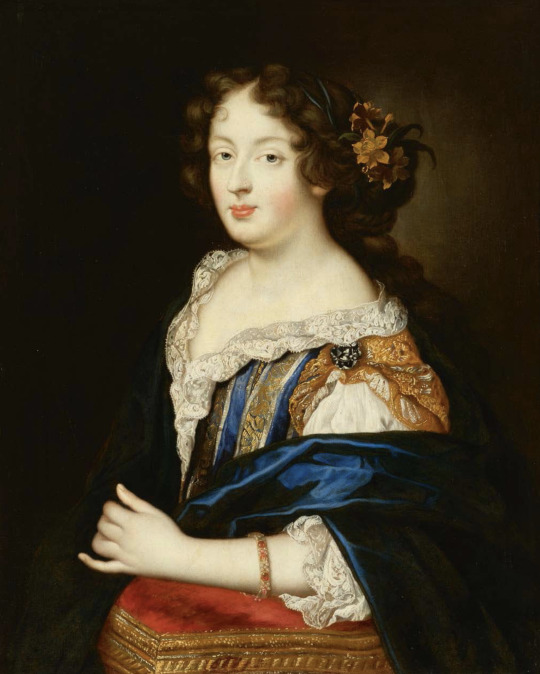
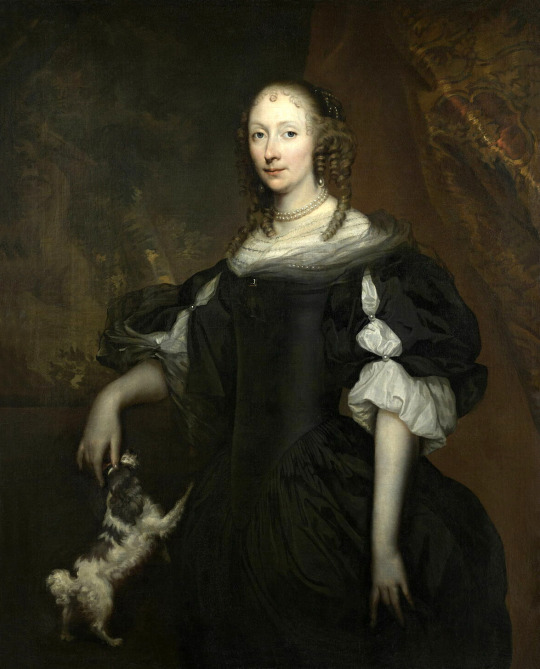
Baroque dresses and a super-celebrity -
Top Lady in a gold and blue dress by Dutch school (location ?). From tumblr.com/catherinedefrance 1280X1673 @72 840kj.
Second row left 1653 Woman by Adriaen Hanneman (State Pushkin Museum - Moskva, Russia). From tumblr.com/history-of-fashion 965X1200 @72 220kj.
Second row right 1670 Dudleia Cullum, née North, Lady Cullum by Sir Peter Lely (St Edmundsbury Museums - St Edmundsbury, Suffolk, UK). From tumblr.com/fashion-inspiration-s; fixed spots w Pshop 989X1200 @72 328kj.
Third row Presumed portrait of Olympe Mancini by French school (Aguttes - 6Dec22 auction Lot 43). From their Web site 2252X2812 @144 4.5Mp. She and her sisters and two related Martinozzi girls made a major splash when Cardinal Mazarin introduced them to the French court.
Fourth row 1660-1680 Noble lady with a dog by Jan de Baen (Louvre). From tumblr.com/history-of-fashion 1176X1456 @72 500kj
#1640s fashion#1650s fashion#1660s fashion#1670s fashion#Baroque fashion#Louis XIV fashion#curly hair#bertha#off shoulder scoop neckline#V waistline#three-quarter length puffed sleeves#over-skirt#Adriaen Hanneman#hair mat#side curl coiffure#hair jewelry#straight neckline#lace modesty piece-bertha#Dudleia Cullum#chemise#Olympe Mancini#hair flowers#off shoulder V décolletage#Jan de Baen
22 notes
·
View notes
Text

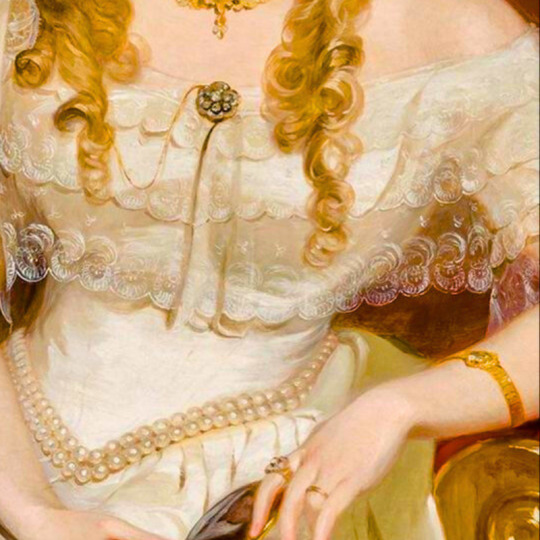



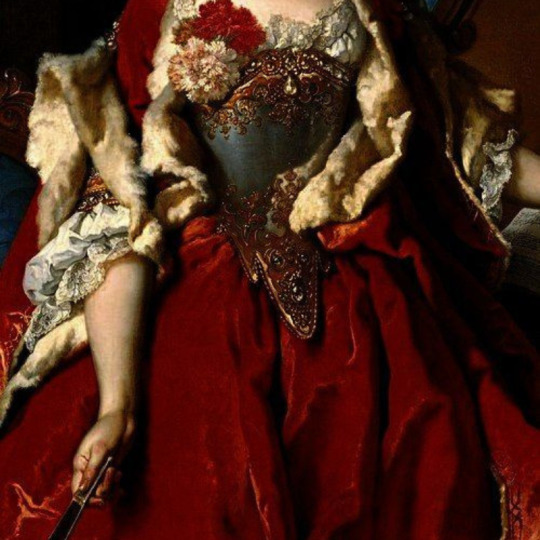


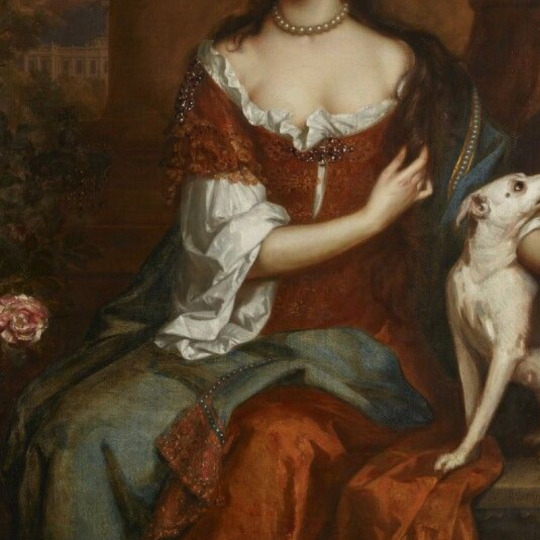


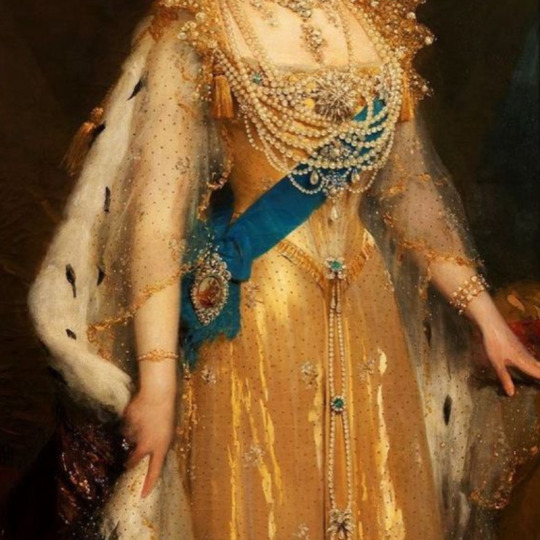
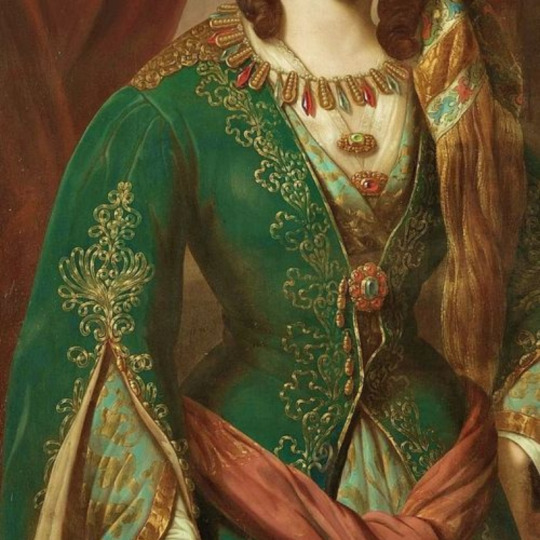

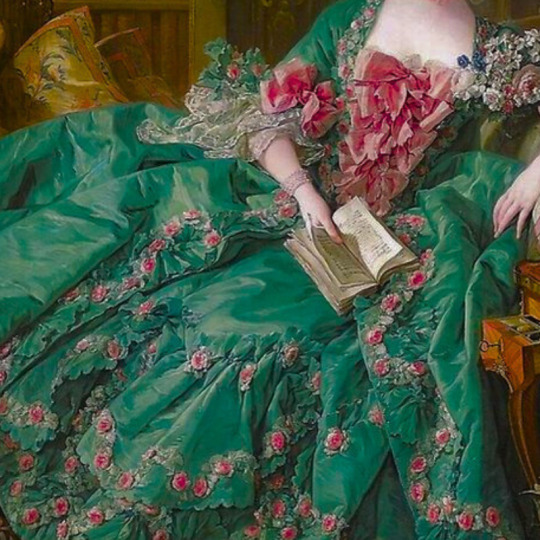

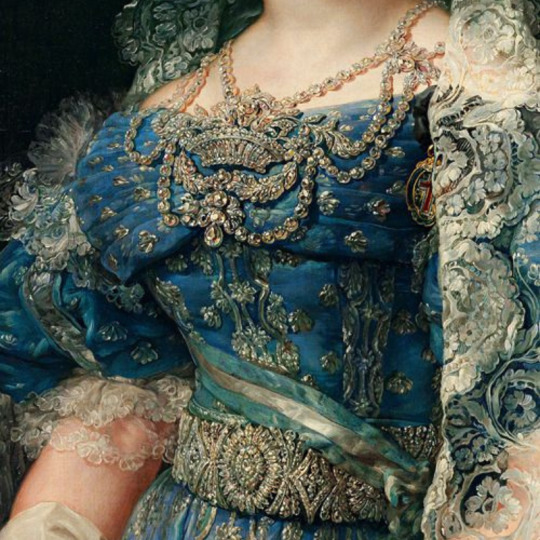



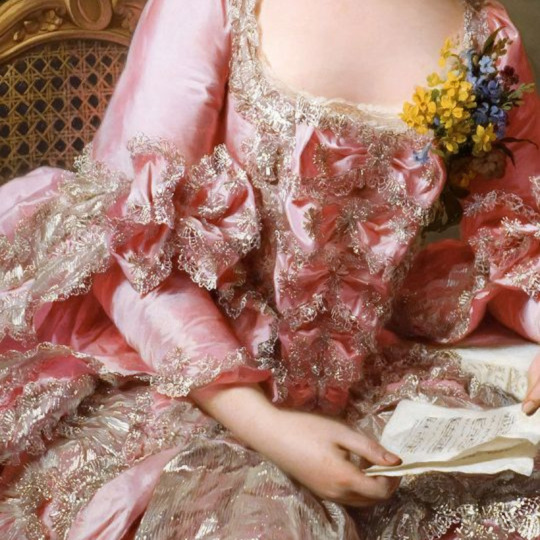





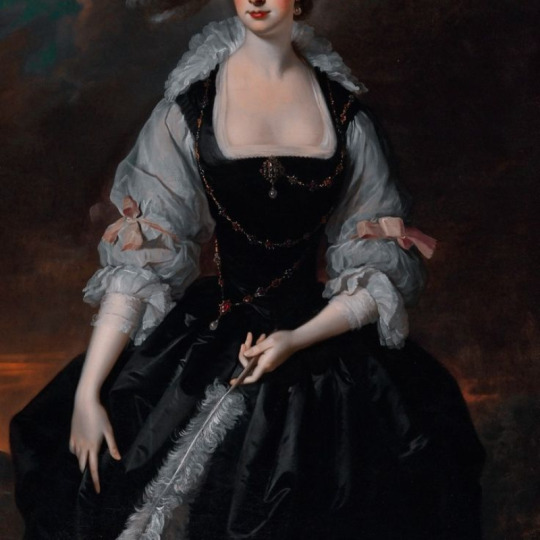
dresses in art
#portrait of the hon. mrs harold by john collier#unknown i cant find this one#portrait of josephine stieler as a bride by joseph karl stieler#portrait of frances anne vane by alexandre jean dubois#portrait of isabelle antoinette barones sloet van toutenberg by nicaise de keyser#portrait of marguerite de seve by nicolas de largillere#portrait of emilia wlodkowska by jozef simmler#portrait of a lady by adriaen hanneman#mary of modena by willem wissing#esther and ahasuerus by artemisia gentileschi#alexandra feodorovna by a malyukov#don't know the artist but its supposed to be the coronation dress of queen alexandra#woman in turkish dress by paul emil jacobs#portrait of juliane by johann heinrich tischbein#portrait of madame de pompadour by francois boucher#princess isabella of asturias vicente palmaroli#maria christina de borbon-dos sicilas reina de espana by vicente lopez y portana#isabella ii queen of spain by federico de madrazo y kuntz#afternoon tea for three by frederic soulacroix#princess maria carolina augusta of bourbon by franz xaver winterhalter#marie suzanne giroust by alexander roslin#the new bracelet by frans verhas#a lady in a lilac dress by wladysaw czachorski#a gust of wind by gaetano bellei#maria grafin zu munster by harry von hente#retrato de dona antonia roca y mestre by angel maria cortellini#frances courtenay by thomas hudson#i loved colorcoding this and i used some from my last edit#art history#history
1K notes
·
View notes
Text
The Wrath of Rampjaar: The Death and Destruction of Johan De Witt
The 1600s was a difficult chapter for human life. All over the world wars tore at the seams of land and families, and those that did not fall in battle found themselves vulnerable to falling from disease and plague brought on by forces that could not yet be understood. Many things that could not be explained resulted in further violence, fanaticism, death, and destruction dealt from one hand only to be horrifically felt by the other. Breakthroughs in science, exploration, and the arts collided with religious extremism and prejudice as humanity as a whole spun on, seemingly with chaos in every corner.
The Netherlands were one part of the world with turmoils erupting within their borders. In 1672 the country formerly known as the Dutch Republic was seeing the end of the “Dutch Golden Age” with simultaneous wars with England, France, and two German cities. The year 1672 would enter the history books as the Rampjaar, The Disaster Year. The Dutch people coined a phrase to describe this most unfortunate time: “The people were irrational, the government helpless, and the country beyond salvation.”

Allegory of the Disaster Year by Jan van Wijckersloot (1673). Image via Wikipedia.
Although it was obvious there were multiple problems facing the Dutch Republic in the 1672, some believed the problems took root decades earlier. William II Prince of Orange died of smallpox in 1650 leaving the Dutch with no official leader (referred to as a Stadholder.) It was this same year that Johan De Witt began to make his mark in the politics of the region. Johan’s family were bitter rivals of the Oranges and as De Witt began to move up the political ladder he allegedly (with the help of his powerful father who spent time in prison for his involvement in a coup d'etat of William II) quietly made moves and had words written into political documents to keep the young William III or any member of the Orange family from ruling. This allowed wheels to be set in motion to form a fully Republican regime with De Witt at the helm. After holding a number of high-standing positions he was elected to the role of Grand Pensionary of Holland in 1653, essentially making him the ruler of all Dutch provinces.
By the time the 1672 Year of Disaster loomed over the Dutch Republic the people had already endured enough war and horror to last a lifetime under the eye of Johan De Witt. There were the Anglo-Dutch Wars which threatened the land, but De Witt remained focused on the sea, taking every step possible to protect the economic interests in shipping and trading that filled his pockets while paying little mind to the forces surrounding the Dutch at their front doors. He also made it a point to delay the appointment of William III as captain general. The stubbornness of De Witt would have deep consequences when in May 1672 Louis XIV invaded the Dutch Republic, thus beginning the third Anglo-Dutch War.
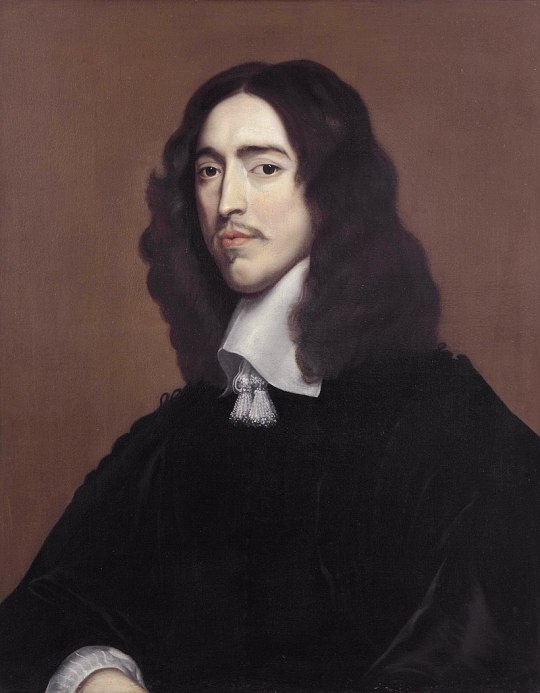
Portrait of Johan De Witt by Adriaen Hanneman (1652). Image via Wikipedia.
As troops moved straight into the heart of their homeland the exhausted Dutch people felt betrayed by their leadership and all eyes turned to Johan De Witt. Some were content to simply, but loudly, voice their opinions that the House of Orange should take back their power by any means necessary. Others showed their feelings of anger and betrayal in much more aggressive ways. On June 21st 1672 Johan De Witt was attacked by a man who was armed with a knife and an intent to kill. The assailant did succeed in brutally stabbing him, but he survived. Johan’s brother Cornelis was also feeling the pressure of the simmering public and on July 24th he was arrested under charges of treason against the House of Orange. He was brought to prison in The Hauge where he was tortured in order to obtain a confession. While his brother was recovering from being nearly assassinated, Cornelis was refusing to confess to any wrongdoing and was eventually sentenced to exile.
Being attacked with a malicious blade changed De Witt and after a lengthy recovery he resigned from his position on August 4th 1672. At the time of his resignation his brother Cornelis was still wallowing in prison with his exile looming. On August 20th Johan visited his brother at the prison to assist him and see him off on what was supposed to be his date of forever departure from his homeland. It is unknown what the pair discussed that day, but it is almost certain they had no clue what was about to happen. Yes, Johan resigned and Cornelis was exiled, but the Dutch people were not ready to let the brothers walk peacefully away into a new chapter while they were left with suffering and debt that could follow them for generations. As the brothers talked in the prison they were attacked by a mob that were set on tearing them limb from limb.
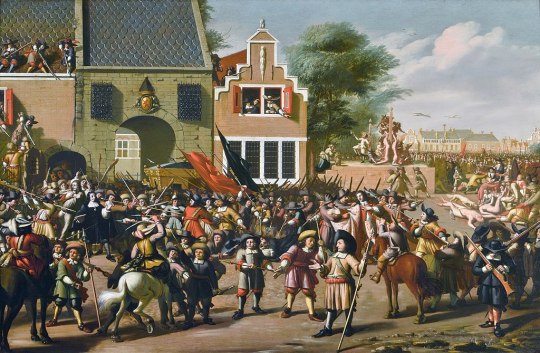
The Murder of the de Witt Brothers by Pieter Fris. Image via Wikipedia.
What unfolded was a scene that was feral, ferocious, and that has gone down in history through eyewitness accounts and multiple pieces of art. The mob ravaged the De Witt brothers. They were dragged into the street, shot, stripped of their clothing, and taken to the public gallows. If the brothers thought their end would be found in a broken neck at the end of a hangman’s noose they were terribly wrong. Once strung up the mob began to take souvenirs. Some accounts report that their eyes were stolen, others say they were later cut into pieces and distributed to the masses, and while that is up for debate one thing that is certain is that their bodies were sliced open, their livers stolen, and the organs were then roasted and consumed by those in attendance. After a lifetime of prestige and twenty years in power, Johan De Witt departed life alongside his brother after being mutilated and cannibalized by his own countrymen.
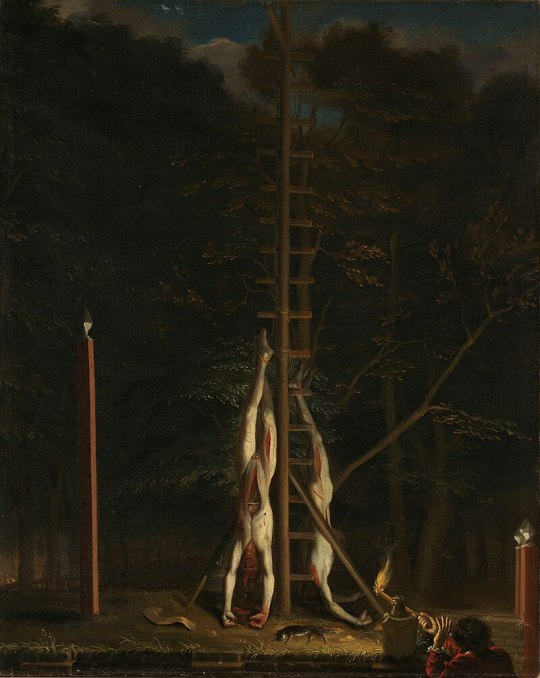
The Corpses of the De Witt Brothers by Jan de Baen. Image via Wikipedia.
With De Witt gone power went to William III of Orange, the same man who had his appointment as captain general stalled by De Witt and the son of William II whose death was used by De Witt and his father to make the turn to the Republican force that they hoped would keep the House of Orange out of power for good.
Whether William III had a hand in planning the attack and death of the De Witt brothers is debated to this day with answers unknown.
Today the prison where the De Witt brothers spent their last moments on earth still stands and has been repurposed as a history and art museum.
**********************************************
Sources:
That Time the Dutch ate their Prime Minister by Vlad Moca-Grama. DutchReview.com, March 3rd 2023. https://dutchreview.com/culture/dutch-history-crowds-ate-prime-minister/
A Dark and Stormy Bite: That Time a Bunch of Dutch People ate Their Prime Minister by Lillian Stone. TheTakeout.com, January 15th 2021. https://thetakeout.com/a-dark-and-stormy-bite-that-time-a-bunch-of-dutch-peop-1846044366
Johan De Witt. Encyclopedia.com.https://www.encyclopedia.com/history/encyclopedias-almanacs-transcripts-and-maps/johan-de-witt
#husheduphistory#featuredarticles#history#forgottenhistory#strangehistory#weirdhistory#tragichistory#historyclass#truestory#truth is stranger than fiction#DutchHistory#NetherlandsHistory#JohanDeWitt#ShockingHistory#horrorhistory#sadstory#HollandHistory
3 notes
·
View notes
Text
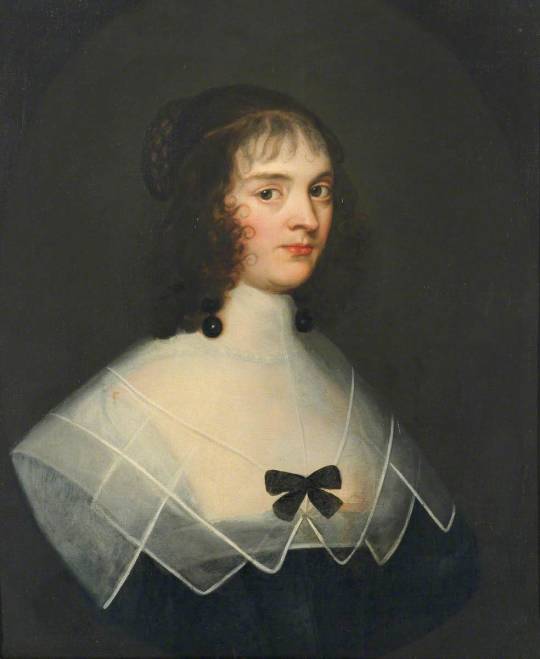
Dorothy, Lady Leventhorpe (c. 1603-1643) by Adriaen Hanneman
34 notes
·
View notes
Photo

Portrait of Emilie von Hessen-Kassel (1656). Adriaen Hanneman (Dutch, c.1604-1671). Oil on canvas.
Amalia von Hesse-Kassel was the daughter of William V, Landgrave of Hesse-Kassel and Amalia Elisabeth von Hanau-Münzenberg. In 1648 she married Henry Charles de la Trémoille, Prince of Taranto, son of Duke Henry de Trémoille and of Thouars and Maria de la Tour d’Auvergne. This striking portrait reflects the influence of Hanneman's contemporary, Anthony van Dyck. Both artists worked in England during the 1630s and may well have had contact there.
18 notes
·
View notes
Photo
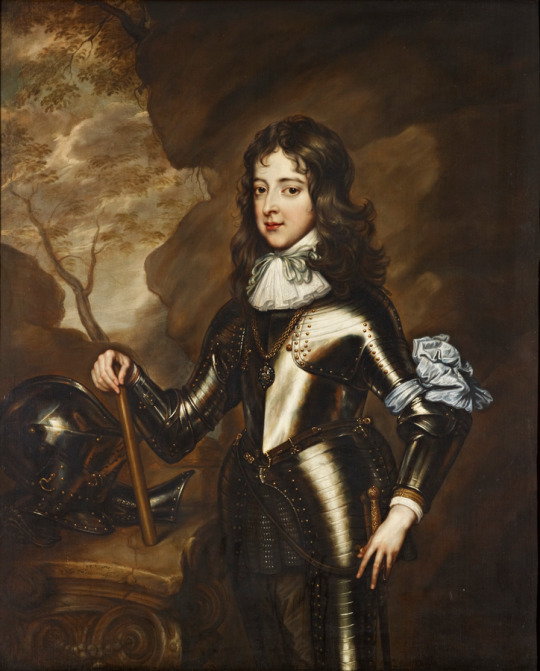
Adriaen Hanneman - William III, Prince of Orange when a child - 1664
William III (William Henry; Dutch: Willem Hendrik; 4 November 1650 – 8 March 1702),[b] also widely known as William of Orange, was sovereign Prince of Orange from birth, Stadtholder of Holland, Zeeland, Utrecht, Guelders, and Overijssel in the Dutch Republic from the 1670s and King of England, Ireland, and Scotland from 1689 until his death in 1702. As King of Scotland, he is known as William II. He is sometimes informally known as "King Billy" in Ireland and Scotland. His victory at the Battle of the Boyne in 1690 is commemorated by Unionists, who display orange colours in his honour. Popular histories usually refer to his joint reign with his wife, Queen Mary II, as that of "William and Mary".
William was the only child of William II, Prince of Orange, who died a week before his birth, and Mary, Princess of Orange, the daughter of Charles I of England, Scotland, and Ireland. In 1677, during the reign of his uncle Charles II of England, Scotland, and Ireland, he married his cousin Mary, the eldest daughter of his maternal uncle James, Duke of York. A Protestant, William participated in several wars against the powerful Catholic king of France, Louis XIV, in coalition with both Protestant and Catholic powers in Europe. Many Protestants heralded him as a champion of their faith. In 1685, his Catholic uncle and father-in-law, James, became king of England, Scotland, and Ireland. James's reign was unpopular with the Protestant majority in Britain, who feared a revival of Catholicism. Supported by a group of influential British political and religious leaders, William invaded England in what became known as the Glorious Revolution. In 1688, he landed at the south-western English port of Brixham. Shortly afterwards, James was deposed.
William's reputation as a staunch Protestant enabled him and his wife to take power. During the early years of his reign, William was occupied abroad with the Nine Years' War (1688–97), leaving Mary to govern the kingdom alone. She died in 1694. In 1696, the Jacobites plotted unsuccessfully to assassinate William and return his father-in-law to the throne. William's lack of children and the death in 1700 of his nephew Prince William, Duke of Gloucester, the son of his sister-in-law Anne, threatened the Protestant succession. The danger was averted by placing distant relatives, the Protestant Hanoverians, in line to the throne with the Act of Settlement 1701. Upon his death in 1702, the king was succeeded in Britain by Anne and as titular Prince of Orange by his cousin, John William Friso.
Adriaen Hanneman (c. 1603 – buried 11 July 1671) was a Dutch Golden Age painter best known for his portraits of the exiled British royal court. His style was strongly influenced by his contemporary, Anthony van Dyck.
25 notes
·
View notes
Photo

Autorretrato de Adriaen Hanneman, 1656
2 notes
·
View notes
Photo

Adriaen Hanneman (c. 1603 - 1671)
Portrait d’un enfant tenant une poule (Portrait of a Child Holding a Chicken), ca. 1650. Oil on canvas 85 x 61 cm
Gazette Drouot auctions, 2019
or
Johannes Van Noordt IV (1620 - 1676)
Girl with a Pigeon
MAÎTRES ANCIENS DESSINS & TABLEAUX. 14 novembre 2019 Drouot, Paris (catalogue p. 72)
the bird is a pigeon and the img is lovely anyway
#Adriaen Hanneman#Renaissance#painting#Flemish#Dutch#chicken#child#portrait#pigeon#error#Johannes Van Noordt#animals
1 note
·
View note
Photo
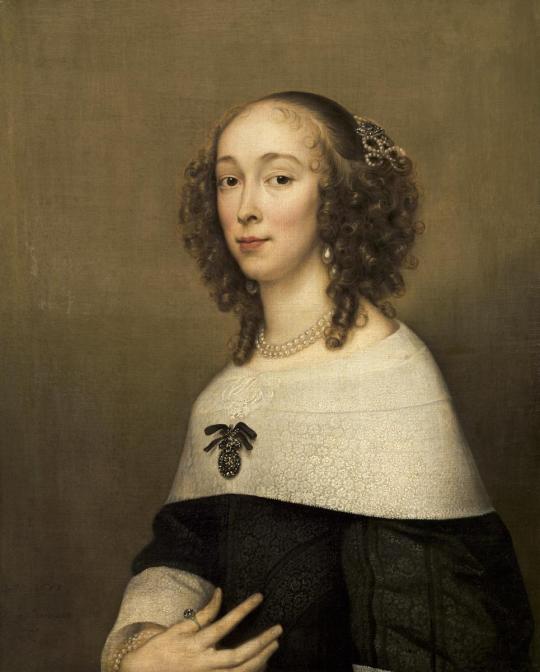
1653 Adriaen Hanneman - Portrait of a Woman
(Pushkin State Museum of Fine Arts)
314 notes
·
View notes
Photo

English School, formerly attributed to Adriaen Hanneman; 'Portrait of a Gentleman, probably Captain Joseph Poole of Sykehouse, wearing armour and standing in a landscape', 1700s, oil on canvas, currently for sale to benefit the Worcester Art Museum est. 10,000 - 15,000 USD in Sotheby's Old Masters Online auction, May 2019.
The young man clad in armor in this impressive portrait stands in a landscape gesturing towards a fortress in the background that is identifiable as Pontefract Castle in West Yorkshire. It was the site of a series of famous sieges during the English Civil War of the 17th century. The sitter has traditionally been identified as “Captain Poole” and is likely to be Captain Joseph Poole Esq. of Sykehouse ( d. 1704), who was a captain in the Parliamentary army and involved in the siege of Pontefract Castle. He wears armor loosely based on English Greenwich armor of the early 17th century. This portrait and the following lot were in the collection of the Higgins Armory Museum in Worcester, MA, founded by John Woodman Higgins (1874-1961). Opened in 1931, it displayed his vast collection of arms and armor in a building specifically constructed for that purpose. The collection was transferred and integrated into the Worcester Art Museum in 2014. [source]
#english school#adriaen hanneman#unknown artist#known sitter#unknown sitter#1700s#oil on canvas#sothebys#worcester art museum#sykehouse#pontefract castle
16 notes
·
View notes
Photo

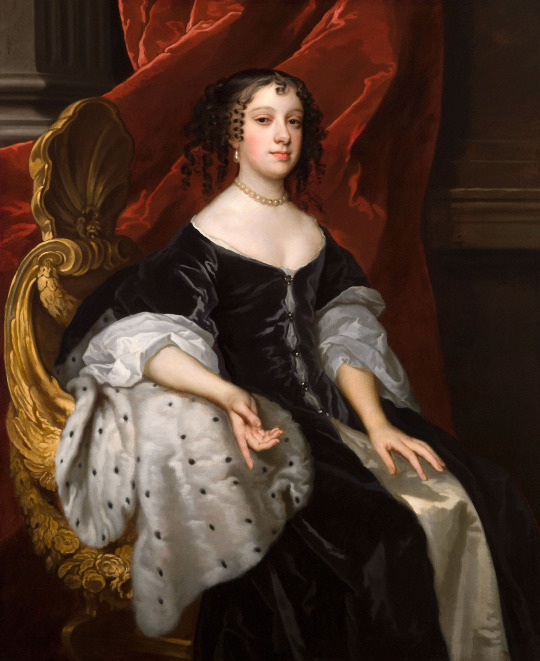
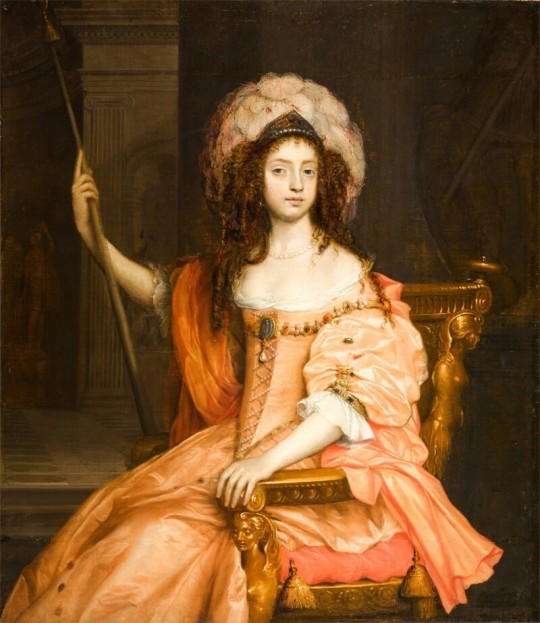



Baroque era dress -
Top 1656 Amalia von Hesse-Kassel by Adriaen Hanneman (Sotheby's 28Jan16 auction Lot26)2880X3559 @72 2.3Mj.
Second row left 1665 Catherine of Braganza, Queen consort of England, Scotland, and Ireland by Sir Peter Lely (location ?). From tumblr.com/blog/view/costumedufilm 1568X1920 @72 792kj.
Second row right Lady, possibly Catherine of Braganza by John Michael Wright (private collection). From tumblr.com/roehenstart 800X923 @72 207kj.
Third row 1660s Jacquemijna Le Pla by Abraham van den Tempel (auctioned by Sotheby's). From tumblr.com/blog/view/the-perdita 1280X1604 @72 749kj.
Fourth row left 1670 Maria Dircksdr Bogaert by Gerbrand van den Eeckhout (Kremer Collection - Amsterdam, Netherlands). From tumblr.com/shewhoworshipscarlin 1122X1300 @72 293kj.
Fourth row right 1660-1680 Noble lady with a dog by Jan de Baen (Louvre). From tumblr.com/the-perdita.
#1650s fashion#1660s fashion#1670s fashion#Baroque fashion#English restoration fashion#Louis XIV fashion#Amalia von Hesse-Kassel#Adriaen Hanneman#side curl coiffure#hair mat#off shoulder scoop neckline#puffed sleeves#V waistline#Catherine of Braganza#Peter Lely#split bodice#robes#John Michael Wright#feather headdress#tiara#laced bodice#chemise#modesty piece#Jacquemijna Le Pla#Abraham van den Tempel#Maria Dircksdr Bogaert#Gerbrand van den Eeckhout#lace bertha#Jan de Baen#sheer bertha
17 notes
·
View notes
Text
You know. Sometimes when I’m drawing, I just feel like I’m creating the second picture in the “Fruit, fruit!” dichotomy in Black Sails.
#black sails#fruit fruit#'This is the work of Adriaen Hanneman. A master work unmistably'#'This... is an abomination'#hopefully not that bad#but that's sometimes how it feels in the middle of it all#drawing something new#and it's not quite coming out right#and given the reception of my last drawing I'm feeling a little intimidated lol#apparently people really liked that one!#but will they like the next one hmmmmmm
9 notes
·
View notes

